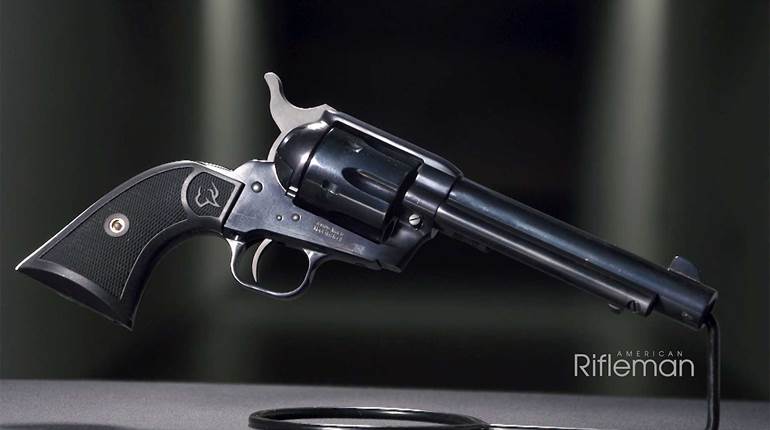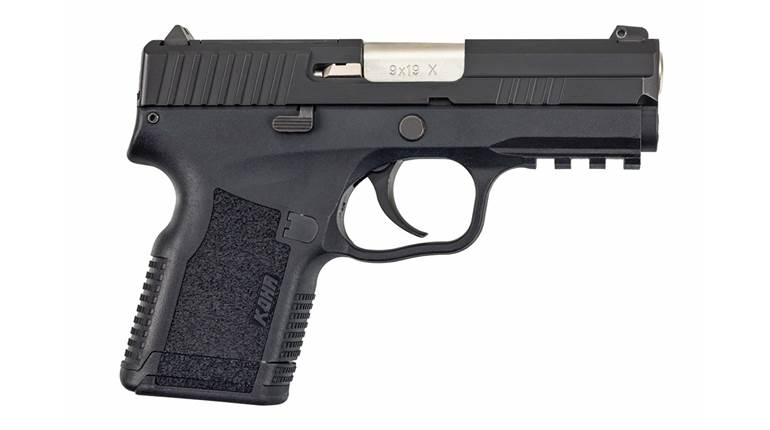
3/20/2013
If you flashed the silhouette of a Government Model pistol on the screen in an auditorium full of gun people and asked them what they had just seen, how would they answer? Some would identify it as a “Colt Government Model,” others as an “M1911” and a few might even rattle off the full military designation. But I’ll bet that just as many would also say nothing more than “.45.” In one way or another, they would all be right. For 102 years (and-counting), the fortunes of that wonderful old gun have been closely intermingled with the development and use of the equally impressive .45 ACP cartridge. Except when used as a club, the pistol never killed anyone. Lethal effect came from the ammunition fired in the gun and, more specifically, that jacketed, 230-grain bullet at 850 fps. It is therefore understandable that the term “Forty-five” has been used to describe both a pistol and a cartridge. Millions of Government Models have been made in the past century or so, and the overwhelming majority were, in fact, .45s—but not all.
There were an even dozen calibers chambered in the M1911 pistol by Colt’s Mfg. in Hartford. At the outset, understand that we will deal exclusively with the products of the original developer/manufacturer—Colt. I also know that there are several wildcat cartridges (.38-45, .460 Rowland, .45 Super, .38 Casull) that can be made to work in the original M1911 platform. Since they were not legitimized as original Colt factory chamberings, they won’t be included in this discussion. Also understand that I will include only M1911 pistols and their immediate derivatives—Commanders, Officer’s Models, Defenders, CCOs and the like.
It all began with the .45 ACP (.45 Automatic Colt Pistol) in the first decade of the 20th century. Colt had produced a commercially successful semi-automatic pistol in 1905 that used a cartridge virtually identical to the .45 ACP of the M1911 gun in the dimensional sense, differing only in the way it was loaded. The hotter loadings of the M1911-era produced ammunition delivering a 230-grain bullet at 820 fps. Ammunition boxes of World War I were so marked. Somewhere along the way, it was increased to 850 fps. From its inception and first use in the Mexican Punitive Expedition of 1916 to its use Afghanistan today, the .45 ACP has been a reliable fight-stopper. It has also survived a great deal of developmental effort to temper its recoil, increase its velocity and maximize its terminal effect. Today’s well-designed jacketed-hollow-point bullets have made the .45 ACP cartridge markedly more effective, and the best of them function on the basis of a proven formula—a 230-grain bullet at 850 fps. This, along with such perennials as the .38 Spl. and 9 mm Luger, are true classics that are still going strong.
The United Kingdom was up to its hip pockets in war by 1914, and it needed guns with which to fight. Early on, quantities of commercial M1911 pistols in .45 ACP went to dealers in England and were used in the war, but the British eventually ordered Colt M1911s chambered for the .455 Webley (a.k.a., .455 Webley Self Loading Pistol Cartridge, Mark I). This cartridge was originally developed for a Webley .45 automatic pistol used by the Royal Navy. Requiring engineering changes to the Colt pistol, the cartridge was matched to a modified gun. Although the .455 is commonly described as “interchangeable” with the .45 ACP, neither cartridge should be fired in a gun for which it is not chambered. Colt enjoyed brisk foreign sales in those early days, but most guns were .45 ACPs. Model 1911s in .455 Webley had a “W” prefix in the serial number and are a rare find for today’s collector.
As time passed, the M1911 pistol’s reputation was established in military circles and growing in both police and civilian ones. A series of prudent updates came along in the 1920s, thereby establishing the M1911A1 variant. In response to police requests for a Government Model pistol chambered in a cartridge with better metal-piercing capabilities, Colt introduced the .38 Super Automatic +P in 1929. The new cartridge was dimensionally identical to the .38 ACP cartridge used in the 1902 Model. Loaded to produce significantly higher velocities (up to as much as 1,300 fps), the Super was a success, with more than 200,000 pistols sold between 1929 and 1969, when the Series 70 guns were introduced.
The Super got a real boost in the 1970s, when aftermarket barrels from Bar-Sto were introduced that corrected the Super’s marginal headspacing system. All of a sudden, the Super was match-accurate. Always popular in Mexico and other Latin American countries, the Super is one of the Colt standard chamberings and has been made in many variations.
As soon as the .38 Super was launched, Colt introduced a 1911A1 pistol chambered for the diminutive .22 Long Rifle cartridge. Primarily intended to be a device for low-cost, low-noise, low-recoil training, the gun was called (and marked) the Ace. The engineering required to make it function reliably was more difficult than it would appear. Unlike the .45 ACP pistols, the Ace was a blowback, so the weight of the slide had to be balanced against the strength of the recoil spring. Ace slides are actually just slightly shorter than the .45’s. At best, the original Ace was a problematic pistol in the functioning sense, so Colt tried a Service Ace in 1937. It used a so-called “floating chamber” designed by David “Carbine” Williams. It was an improvement in the sense of reliability, but Colt discontinued the model after a short post-World War II run. The .22 Long Rifle chambering died with it. That changed a couple of years ago with the introduction of the Government Model .22.
In the world of small arms, many precedents were established by the experiences of World War II. Among them was the universal respect for the German service pistol cartridge and even the possibility of American use thereof. In 1949, on the prospect of large Government contracts, Colt chambered an M1911 variant for the 9 mm Luger (a.k.a., 9 mm Parabellum, 9x19 mm NATO). Once again, clever engineering permitted the platform to accept a shorter-than-ACP cartridge in the longer receiver. One of the tricks was a magazine with a filler block in the rear edge that kept the cartridges in position for feeding. Although the first of the new aluminum-frame, short M1911 pistols were in fact chambered for the 9 mm Luger, the big government contracts did not materialize. Colt then adapted its Commander Model to the proven .45 ACP for a long and successful career. The 9 mm chambering did persist in smaller, but still significant numbers and does so to the present day. A light 9 mm M1911 makes a great gun for a shooter who has problems with recoil.
NRA Outdoor Pistol competition bloomed in the 1950s and ’60s. Bullseye pistol was a game that required a .22, a .45 and another gun in “any center-fire” caliber. Usually that meant both .22 and .45 stages fired with semi-automatics and the center-fire stage with a .38 revolver. A few custom gunsmiths had converted .38 Supers to fire a similar-size revolver cartridge. In 1960, Colt offered a version of their glossy National Match (later Gold Cup) pistol in .38 Spl. Because of cartridge length issues, the pistol worked only with full wadcutter bullets seated flush with the case mouth. It was a fine match pistol that fitted a specific, but limited need. Sales of .38 Gold Cups were steady for many years.
Exactly the same reasoning went into the development of M1911 pistols chambered for the .38 AMU (a.k.a., .38 Army Marksmanship Unit) designed by the U.S. Army unit at Fort Benning. It was a rimless version of the .38 Spl., and most of the pistols with that designation on the slide were actually built from Colt-made kits assembled by AMU gunsmiths. Some kits were sold by Gil Hebard Guns. The guns have a good reputation, but they were competing with the S&W Model 52. Some readers will question the existence of any Colt-made .38 AMUs; my reference says that some were made.
Colt made some changes as the 1960s rolled into the ’70s, and that included more than just markings, marketing and a collet barrel bushing. There seemed to be a greater openness to new ideas and a new aggressive attitude about the catalog. For the purposes of our caliber count, no less than five new chamberings found their way into that old reliable platform. Two of them were made in small numbers for sale abroad. They were the 7.65 Parabellum (.30 Luger) and 9 mm Steyr (a.k.a.. 9 mm Mannlicher, 9 mm Steyr-Hahn). The .30 Luger was one of early automatic pistol cartridges and was originally designed for the Luger pistol. It faded fast when the 9 mm Luger came along. Introduced in 1911, the 9 mm Steyr was developed for the Steyr-Hahn pistol used by the Austro-Hungarian Army, as well as Romanian and Chilean forces. Used in great numbers by Germany in World War II, there are many examples extant. In the Colt pistol caliber chronology, they are almost a footnote.
In the mid-1980s, Americans were clamoring for a medium-bore, high-velocity pistol cartridge. The 10 mm Auto was developed for the Bren Ten pistol and almost died with it when the gun’s maker encountered business difficulties. Colt literally rescued the cartridge from extinction with an M1911 variant called the Delta Elite. Early loadings of the 10 mm were very hot, but ammunition makers prudently learned to tone them down. Current loads are generally tame, but the hotter ones are about 30 percent more powerful than the .45 ACP. I well remember a handloading exercise with a Bar-Sto-barreled Delta. Careful sequential loading with top components at lower velocities produced the tightest pistol group I can recall. At 25 yards, 10 rounds went into 0.58 inches.
By 1996, American shooters were spending great time and effort on defense-based shooting sports that required a lot of attention to the power level, or kinetic energy, developed by a load. Since it was for competition, everyone wanted the lowest energy possible, as long as it made the major caliber floor. That’s because it was easier to shoot. Working with Winchester, Colt developed Government Models chambered for a new cartridge called the 9x23 mm Winchester. A brilliantly engineered cartridge, the 9x23 mm appears to be a 9 mm Luger case extended by 4 millimeters. It is actually much more than that, since the case web is specifically built to accept high pressures. For some reason, the 9x23 mm never really caught on and disappeared from the scene. It was exceptionally hot, driving a 124-grain, 0.355-inch bullet to almost 1,500 fps. I have reloading data from an impeccable source that goes well beyond that. Like the high-performance 10 mm Auto before it, the 9x23 mm produced stresses that were hard on the rugged M1911 platform and harder still on shooters unaccustomed to recoil and muzzle blast.
Smith & Wesson joined forces with Winchester Ammunition to produce one of the most popular new cartridges ever offered. In order to split the difference between the magazine capacity of the popular 9 mm guns and the decisive power of the big bores, the Winchester/S&W effort produced the .40 S&W in 1990. Colt had no real need to get into that business, so it chambered only a few M1911 models in that highly interesting caliber. In one of the “little” M1911s—Defender or Officer’s ACP—the .40 S&W starts to make some sense. Also, there are two different men in my circle of gun friends who have reported handling full-size Colt M1911s in .40 S&W.
That’s it—twelve chamberings—in just more than a century of M1911 gunmaking at Colt. The preceding listing is as complete and accurate as I can make it, but I concede the possibility that something was left out. In that regard, I know about the 9.8 mm Colt/9.65 mm Browning. I don’t consider that to be a true M1911 pistol. If anyone can tell me of other calibers originally chambered at Colt’s of Hartford in a true M1911, please write and tell me. I will ensure that shooters everywhere get the word.





































